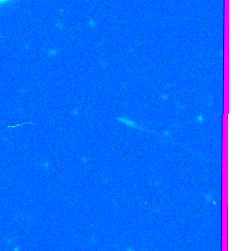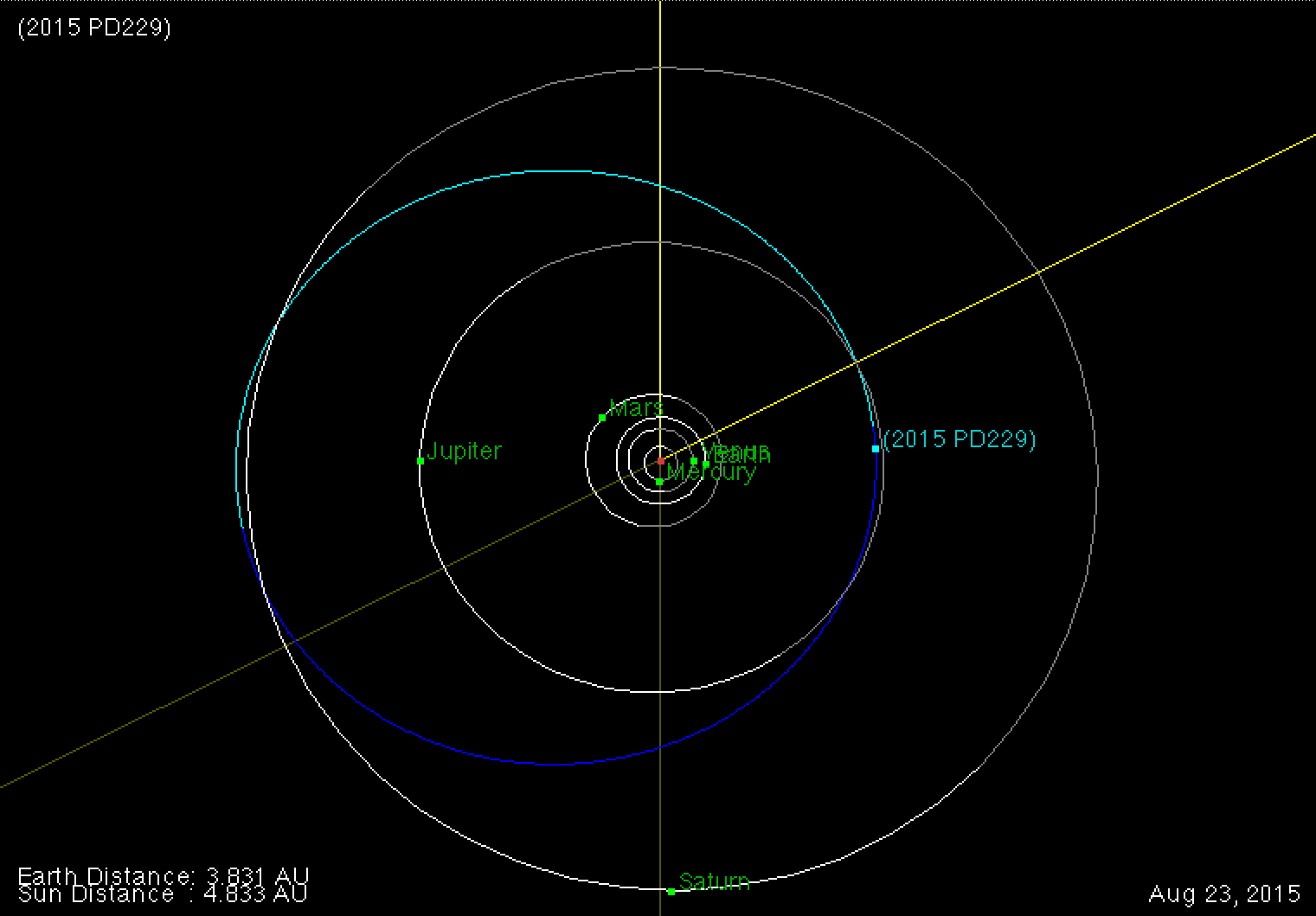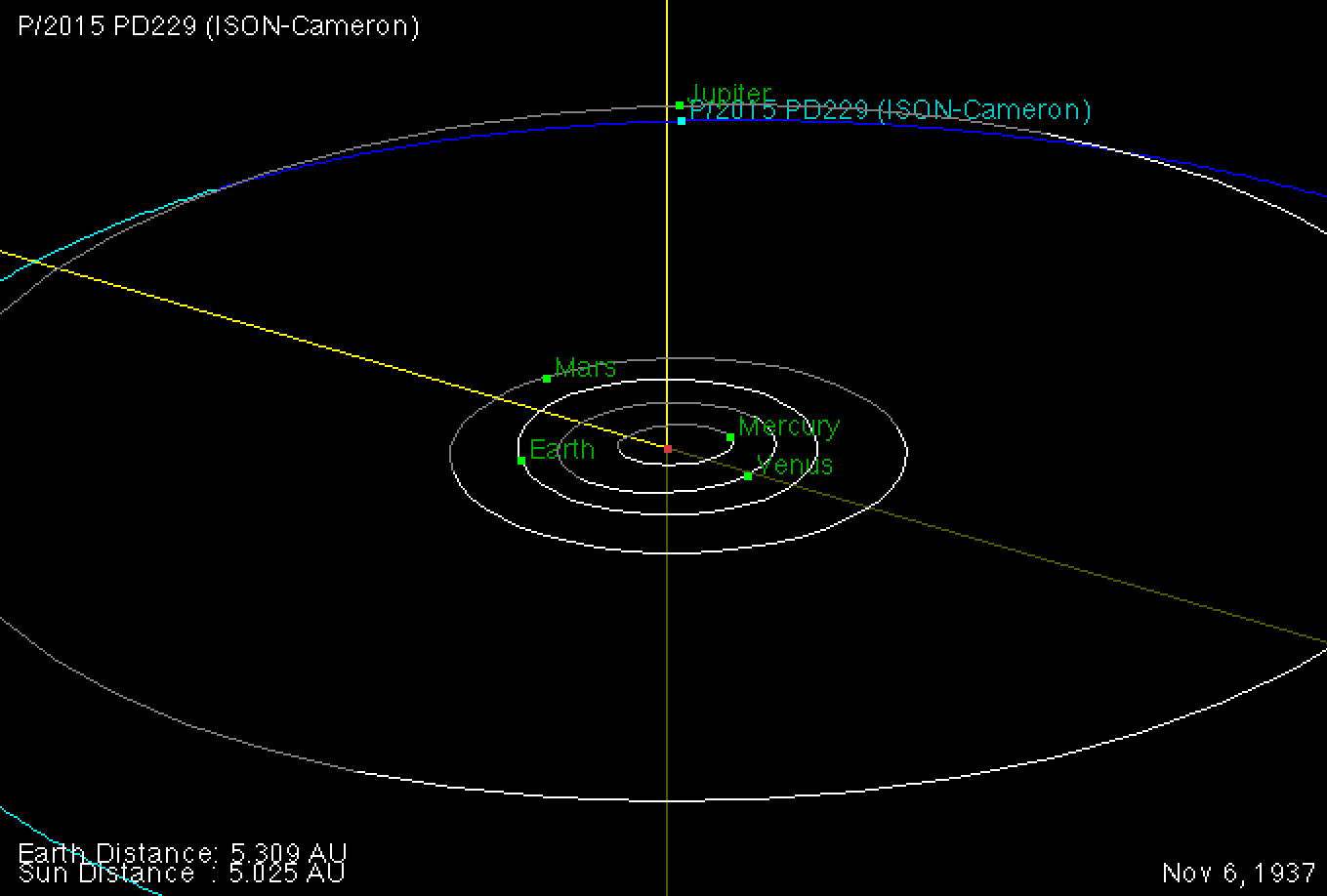COMET P/2015 PD229 (ISON-Cameron)

First observations of a candidate comet seen by Dave Cameron (U. Rochester) in Blanco 4-m DECam images taken in broad "VR" band filter, UT 27 and 28 May 2015. First epoch observations at 22:42:27.81-08:47:57.6 (J2000) on UT May 27.3618, magnitude r ~ 22.3. Frames are NOAO DECam pipeline DECAL images, obviously no attempt has been made to subtract cosmic rays in these images.
UPDATE 18 Aug 2015:
IAU Minor Planet Center has designated this object 2015 PD229, it was recently seen by some other observers and is apparently V ~ 19th magnitude now, but none of the recent observers have noted a cometary appearance yet.UPDATE 1 Feb 2016:
Minor Planet Center has designated the object a comet with designation COMET P/2015 PD229 (ISON-Cameron). While we reported the observatons 14 Aug 2015, they were not processed by MPC until shortly after they processed observations by the ISON group (which were later epoch). As the object was first designated 2015 PD229 based on the ISON observations, their name is incorporated into the comet name. "Cameron" is Dave Cameron (visiting scientist at University of Rochester), who first noted the cometary appearance of the object in August 2015 in the DECam images from UT 27/28 May 2015. The observations were taken during an observing run on the Blanco 4-m telescope during the DECam observing program 2015A-0205 (PI: Eric Mamajek, University of Rochester).Orbit
The object is a Jupiter-family comet (originally considered an "active" Centaur). Here is the link to the JPL Small-body Database Browser page for 2015 PD229. The current position of the comet with respect to the planets can be seen here. The orbit has semi-major axis a = 7.18 AU, period P = 19.23 years, eccentricity e = 0.33, periastron q = 4.83 AU, inclination i = 2.03 deg, ascending node = 342.77 deg, argument of perihelion = 352.40 deg. Perihelion is predicted for 30 Aug 2015, just inside Jupiter's orbit (although Jupiter is exactly on the opposite side). The inclination is intermediate to Jupiter and Saturn: i(Jupiter) = 1.30 deg, i(Saturn) = 2.49 deg, i(PD229) = 2.03 deg.
It looks like comet P/2015 PD229 (ISON-Cameron) may have had a close pass to Saturn around 1889, Jupiter around 1937/1938, followed by a less close pass of Saturn around 1948/1949:

Initial Notes on Initial Observations
Submitted positions, times, photometry in MPC format (minus email address):
COD W84
CON D. A. Cameron, PAS, U Rochester, Rochester, NY 14627
OBS E. E. Mamajek, F. Moolekamp, D. J. James, D. A. Cameron
MEA D. A. Cameron
TEL 4.0-m CTIO Blanco reflector
NET 2MASS
ACK MPC submission ID DC0305
PDC0305 HC2015 05 27.36183922 42 27.81 -08 47 57.6 22.3 N W84
PDC0305 HC2015 05 27.38330822 42 28.38 -08 47 54.0 22.8 N W84
PDC0305 HC2015 05 27.40479922 42 28.93 -08 47 50.4 22.6 N W84
PDC0305 HC2015 05 27.42635222 42 29.49 -08 47 46.8 22.2 N W84
PDC0305 HC2015 05 28.36108122 42 54.13 -08 45 12.3 22.1 N W84
Dave Cameron first noted this object looking at images from NOAO Program 2015A-0205 (PI Mamajek; https://www.noao.edu/noaoprop/abstract.mpl?2015A-0205).
Notes: Definite tail to southwest. Appearance looks like 5"x1" "coma" with 16" tail to southwest (PA = 246.7 = 180 + 66.7 deg). However, images are 15-min exposures with ~1" seeing, and object is moving 17.67"/hour, so object moves 4.4" within 15 minutes, hence the "coma" is probably just a smeared-out point source (either not resolved, or negligibly resolved) - similar to the seeing (1"), stretched out due to motion. However, there is a ~16"-long tail, of which only 4.4" can be attributed to motion alone. So the intrinsic tail length is probably ~12". As calculated below, the objects motion is towards PA = 67.05 deg, however the tail is oriented towards PA = 246.7 = 180 + 66.7 deg. The ecliptic pole is towards PA = 337.96. So the objects motion and tail are within ~0.4 deg of one another, the motion is within 0.9 deg of the ecliptic plane, and the tail is within 1.3 deg of the ecliptic plane. So this would seem to be a candidate comet in the main belt, with low inclination.
CALCULATIONS AND NOTES:
Motion over the 5 frames (over two nights):
Delta(time) = 28.361081 - 27.361839 = 0.999242 day = 23.9818 hr = 86334.5 sec
Position(start) = 340.615875000000 -8.799333333333
Position(final) = 340.725541666667 -8.753416666667
Start->Final:
Position Angle [deg] = 67.0482
Delta(X) ["] = 390.201
Delta(Y) ["] = 165.299
Separation \rho [deg] = 0.117707
Separation \rho ["] = 423.748
Angular rate = 423.74817"/23.9818 hr = 17.67"/hr
=> in 15 min => 4.417".
Note that the North Ecliptic Pole (18h +66 33'38.55") is towards PA=337.96deg (90.566 deg away from initial position).